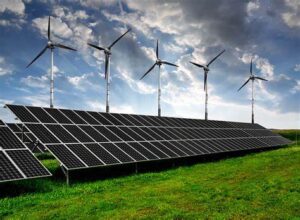On November 16, 2023, the Department of Energy (DOE) published a proposed rule to expedite the environmental review process for certain renewable energy infrastructure projects through the use of categorical exclusions. DOE’s proposal would apply to: (1) installing, operating, modifying, or decommissioning solar photovoltaic (PV) systems on buildings or other structures or within previously disturbed or developed areas; (2) upgrading, rebuilding, or relocating power lines within existing rights of way or on previously disturbed or developed lands; and (3) constructing, operating, upgrading, or decommissioning electrochemical-battery or flywheel storage systems within previously disturbed or developed areas or on small parcels of land contiguous to those areas. As discussed in more detail below, DOE’s new proposal would modify existing categorical exclusions for the first two items and create a new categorical exclusion for the third.
For background, the National Environmental Policy Act (NEPA) requires federal agencies to conduct detailed environmental analyses of major federal actions significantly affecting the environment. Major federal actions include those that are undertaken, funded, or authorized by a federal agency. Thus, for example, where DOE is funding an energy, storage, or power line project, it will be required to conduct an environmental review under NEPA. Actions by power marketing administrations housed within DOE, such as interconnection approvals and transmission system management, may also be subject to the environmental review requirements of NEPA.
For most actions, the agency will first conduct an environmental assessment to determine whether the action has the potential to cause significant environmental impacts. If the agency determines that the action will significantly affect the quality of the human environment, the agency will then prepare an environmental impact statement to more rigorously assess those impacts and alternatives to the project. If the environmental assessment reveals that the project will not create significant environmental impacts, the agency will publish a finding of no significant impact. Federal agencies do not need to prepare an environmental assessment or impact statement for projects that fall within a categorical exclusion. Categorical exclusions apply when the reviewing agency determines that an action is the sort that typically does not have significant environmental impacts and therefore does not require an environmental assessment or environmental impact statement. Categorical exclusions therefore serve as a mechanism for streamlining the review and permitting of certain projects that pose minimal environmental risks.
The key changes DOE is proposing to make to its categorical exclusions are as follows:
- Solar PV Projects: DOE’s current NEPA regulations include a categorical exclusion (Exclusion B5.16) for certain categories of solar PV projects. The current exclusion applies to the “installation, modification, operation, and removal of solar PV systems located on a building or other structure or, if located on land, within a previously disturbed or developed area generally comprising less than 10 acres.” DOE now proposes to remove the 10-acre limitation for projects based on the understanding that “acreage is not a reliable indicator of potential environmental impacts,” and that “the potential significance of environmental impacts is more related to local environmental conditions than to acreage.” DOE is also proposing to replace the current language concerning the “removal of solar PV systems” with new language about “decommissioning of solar PV systems” in order to reach actions (such as recycling) that occur during the decommissioning process.
- Power Line Projects: DOE’s current regulations for power lines likewise contain a limited categorical exclusion (Exclusion C4) for upgrading or rebuilding twenty miles or less of existing power lines and minor relocations of small lengths of power line. As with solar PV systems, DOE now proposes to remove the size (in this case, length) limitation for upgrading and rebuilding power lines, based on the recognition that environmental impacts from such projects are “more related to local environmental conditions than to the length of the powerlines.” DOE also proposes to modify the existing categorical exclusion for “minor relocations of small segments of the powerlines” by deleting the word “minor” and by specifying that power line segments may be relocated “within an existing right of way or within otherwise previously disturbed or developed lands.”
- Battery and Flywheel Energy Storage Projects: Unlike solar PV projects and power lines, battery and flywheel energy storage systems do not currently have their own categorical exclusions. Rather, certain energy storage projects are included in a more general exclusion (Exclusion B5.1) for actions to conserve energy or water, which lists as an example of a conservation action “power storage (such as flywheels and batteries, generally less than 10 MW).” DOE is now proposing to create a new categorical exclusion for the construction, operation, upgrading, or decommissioning of electrochemical-battery or flywheel energy storage systems in previously disturbed or developed areas, along with small areas contiguous to those disturbed or developed areas. DOE proposes to remove flywheel and battery storage systems from the more general conservation exclusion and further proposes not to carry over the 10 MW limitation for project size.
As reflected in DOE’s current categorical exclusions encompassing solar PV, power lines, and battery and flywheel energy storage, DOE has already determined that these projects do not typically cause significant negative environmental impacts, assuming that certain conditions are met. These conditions include the land on which the project is being developed: typically, developed or disturbed land, defined as “land that has been changed such that its functioning ecological processes have been and remain altered by human activity,” or areas contiguous to that land. Before applying any categorical exclusion, DOE also considers whether there are any “extraordinary circumstances related to the proposal that may affect the significance of the environmental effects of the proposal,” including:
- “scientific controversy about the environmental effects of the proposal,”
- “uncertain effects or effects involving unique or unknown risks,” and
- “unresolved conflicts concerning alternative uses of available resources.”
These factors encompass site-specific considerations, such as whether the presence of certain species or environmentally-sensitive resources presents unique environmental risks. DOE’s current proposal is significant for recognizing that—once these specific, local conditions at or near the project site are accounted for—the size of these projects does not independently threaten to create significant environmental impacts. DOE provides several examples of this in its proposal, noting that “the presence of environmentally sensitive resources along the existing right-of-way is more pertinent than the length of the existing powerlines to be upgraded or rebuilt,” and further that “environmental assessments for solar PV projects larger than 1,000 acres on previously disturbed or developed land [have shown that the projects] would not result in significant environmental impacts.” DOE’s proposal is therefore justified on the basis that the agency has determined that certain solar PV, power line, and energy storage projects do not create significant environmental impacts regardless of project size, assuming the projects are sited on disturbed or developed land and that site-specific factors do not exacerbate a project’s impacts. This proposal would bring real benefits, because large-scale clean energy projects, including all three categories of projects included in the proposal–solar, transmission, and storage–are necessary to meet the United States’ goal of 100% clean electricity by 2035.
However, there are limitations to the proposal, including the fact that DOE is not currently proposing to remove the size limitations in several other of its categorical exclusions for renewable energy projects. Most prominently, DOE’s categorical exclusion (Exclusion B5.18) for onshore wind turbines applies only to “[t]he installation, modification, operation, and removal of a small number (generally not more than 2) of commercially available wind turbines, with a total height of less than 200 feet).” This is true even though the categorical exclusion only applies to projects on previously developed or disturbed land, independently considers whether the turbines could cause significant impacts to persons (including through shadow flicker and noise), and independently considers whether the turbines could cause significant impacts to birds and bats. Furthermore, this size limitation exists despite DOE regularly concluding via environmental assessments that significantly larger wind farms would present no significant environmental impacts: for example, in May 2023, DOE published a finding of no significant impact after conducting an environmental assessment for the North Bend Wind Project, which is set to include seventy-one wind turbines, each with a hub height of 292 feet and a blade tip height of 501 feet.
Although wind turbine projects–like any development–can have local environmental impacts, those impacts can be mitigated or eliminated through careful siting, design, and operational practices. As just one example, wind farms—like solar farms—can be sited on contaminated lands, therefore avoiding degradation of open spaces and viewsheds and conflicts with alternative land uses. Furthermore, potential avian impacts are closely tied to the location of wind projects, and DOE separately considers those impacts before applying Exclusion B5.18. And while the construction of wind turbines generates small amounts of greenhouse gas emissions, DOE has recognized that–like solar PV–wind energy significantly reduces greenhouse gas emissions and air pollution emissions in the long term. For all of these reasons, DOE has regularly issued findings of no significant impact after conducting environmental assessments of large wind turbine projects.
DOE should consider applying the logic of its current proposal to its categorical exclusion for wind turbines by removing the project size limitation in Exclusion B5.18 and instead basing its application solely on site-specific factors. If DOE does not remove the project size limitation completely, DOE should consider amending the categorical exclusion to encompass projects that are larger than two turbines and 200 cumulative feet. The complexities of wind turbine siting should not dissuade DOE from this change, because DOE would retain authority to refuse to apply the categorical exclusion based on independent factors such as local avian impacts. Even if the change were made, DOE would still be required to conduct a detailed environmental review when site-specific factors could lead to elevated environmental risks, but it would allow DOE to streamline review when such factors are absent, regardless of project size.
Jacob Elkin is a Renewable Energy Legal Defense Initiative Fellow at the Sabin Center.





